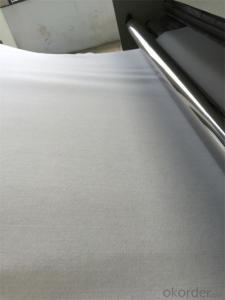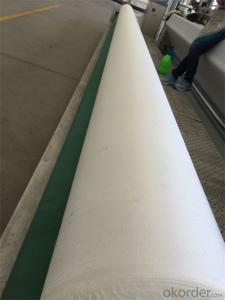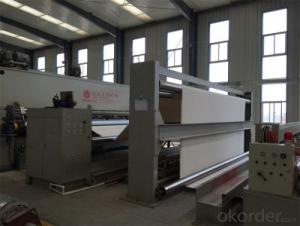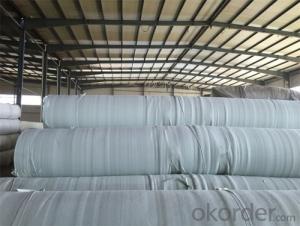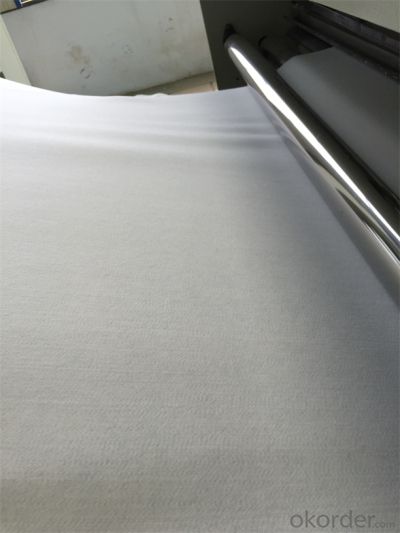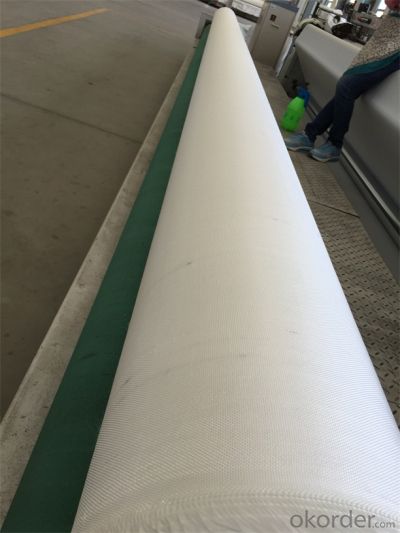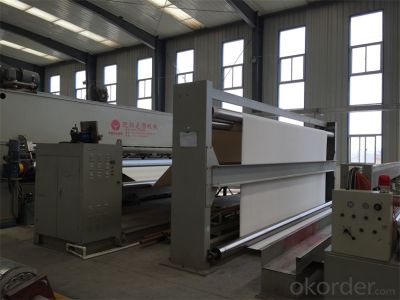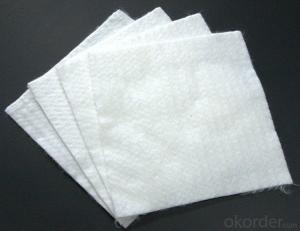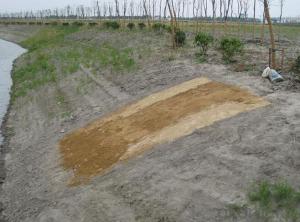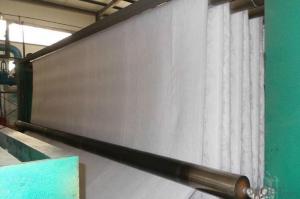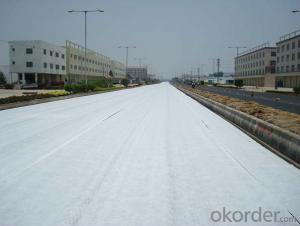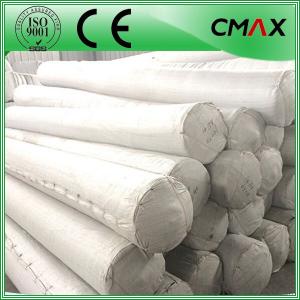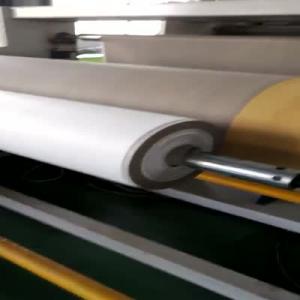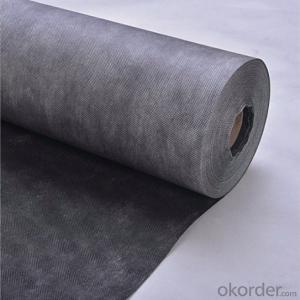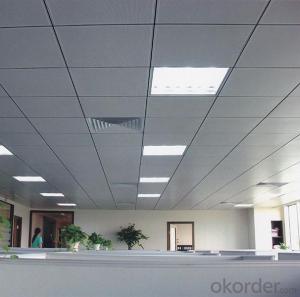PP Nonwoven Geotextile 100g/m2—1200g/ m2
- Loading Port:
- Tianjin
- Payment Terms:
- TT or LC
- Min Order Qty:
- 2000 m²
- Supply Capability:
- 500000 m²/month
OKorder Service Pledge
OKorder Financial Service
You Might Also Like
PP Nonwoven Geotextile
Introdcution of PP Nonwoven Geotextile:
Made from high strength PP (polypropylene) short fiber by nonwoven needle punched manufacturing processing. The mechanical values are 2~3 times more than ordinary products. It has separation filtration drainage reinforcement protection and maintenance etc. function.
Specifications of PP Nonwoven Geotextile:
•100g/m2—1200g/ m2
•1m—8m in roll width
the length as clients’ request
Production Standard:
HSPP-2009-88
Advantage of PP Nonwoven Geotextile:
The mechanical values are 2~3 times more than ordinary products. Good acid and alkali resistance,
Excellent hot melting adhesiveness high anti-abrasion performance.
•Good flexibility resistant to corrosion resistant to acids and alkalis anti-oxidation
•Separation filtration, drainage, reinforcement, protection, and maintenance function
Applications of PP Nonwoven Geotextile:
•Filtration of soils in drainage applications by retaining soil particles while allowing for the free flow of water.
•Separation and stabilization in road and railway construction
•Prevention of soil movement in erosion control measures
•Cushioning and protection in many containment projects
FAQ:
1. Which payment do you accept?
For you convinience,our payment can be L/C,TT
2. Is free sample available?
We can supply free samples. You'll just need to pay for express cost.
3. How about your quality?
We have strict quality control system, we make testing on incoming raw material and finished products. Your third party testing is also welcomed. With high quality, our products are used on government projects at home and abroad. Our product quality is accepted by clients from all over the world.
Photos of Products and Factory:

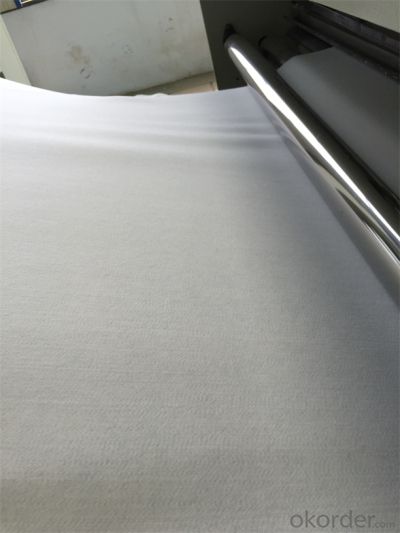


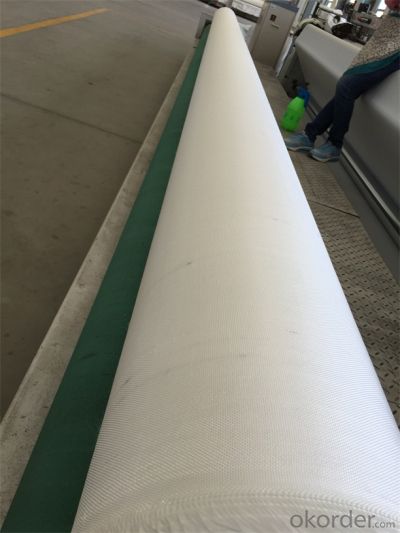
- Q:Eva waterproof board and ecb waterproof board What is the difference between the two
- Both are waterproof panels, can be used for highway, railway tunnel seepage, but the product material is different, the appearance is not the same. EVA waterproof board there are two conventional, one is a simple EVA waterproof board without composite geotextile, the other is a combination of geotextile with the EVA waterproof board. Two collectively referred to as EVA waterproof board are tunnel waterproof board, is the main material of the tunnel seepage. ECB waterproof board there are two conventional, one is a simple white or black ECB waterproof board, the other is with self-adhesive asphalt waterproofing membrane. Both can be used for tunnel seepage.
- Q:Polyester filament geotextile performance characteristics
- Polyester filament geotextile Features: Polyester filament geotextile is made by polyester method by spinning acupuncture consolidation directly made, product specifications from 80-800g / m2 arbitrary choice, it is geotechnical engineering and civil engineering In the application of a geosynthetics, polyester filament into a network and consolidation method, the fiber arranged in three-dimensional structure. In addition to good mechanical properties, but also has a good vertical and horizontal drainage performance and good extension properties and high resistance to biological, acid and alkali, anti-aging and other chemical stability. At the same time, it also has a wide pore size range, tortuous pore distribution, excellent permeability and filtration performance. Polyester filament geotextile Uses: water conservancy project dam and slope protection of the filter, channel isolation, seepage; road, rail, airport runway foundation isolation, filter, drainage, slope, retaining wall and road reinforcement, Drainage; Port Engineering soft foundation treatment, beach embankment, harbor wharf and breakwater reinforcement, drainage; polyester filament geotextile has been widely used in the field of infrastructure construction, and gradually applied to a wider range of areas.
- Q:What is the place of attention for the laying of geotextiles?
- (1) the use of the use of buried type: cover the thickness should not be less than 30cm (2) refurbishment system should be: cushion, impermeable layer, transition layer, protective layer composition. (3) soil to be solid, to avoid uneven subsidence, cracks, anti-seepage within the turf, root to clear. And the surface of the membrane with a small particle size of sand or clay as a protective layer. (4) laying the geomembrane do not pull too tight, both ends of the soil into the corrugated part of the soil is better, especially with the rigid material anchoring, should leave a certain amount of expansion and contraction. (5) construction, should avoid stones,
- Q:How do geotextiles affect visual aesthetics?
- Geotextiles can greatly enhance visual aesthetics by providing a protective layer that improves the overall appearance of landscapes. They can be used to control erosion, stabilize slopes, and prevent weed growth, resulting in cleaner and more organized outdoor spaces. Additionally, geotextiles can be concealed beneath surfaces such as lawns or gravel, maintaining a visually pleasing environment while serving their functional purpose.
- Q:How are geotextiles used in coastal engineering?
- Geotextiles are commonly used in coastal engineering to provide erosion control and stabilization. They are typically used as a layer of fabric or matting beneath coastal structures such as seawalls, revetments, and breakwaters. Geotextiles help to prevent soil erosion, reduce wave energy, and provide stability to the structure. They also allow for water drainage, which helps to prevent hydrostatic pressure buildup and potential damage.
- Q:What are the cost considerations for geotextile applications?
- Some cost considerations for geotextile applications include the initial purchase cost of the geotextile material, the cost of installation, and any additional costs associated with site preparation and maintenance. Other factors such as the size and complexity of the project, the type and quality of the geotextile material, and the expected longevity of the application also contribute to the overall cost. Additionally, the potential cost savings from using geotextiles, such as reduced construction time and improved long-term performance, should also be taken into account.
- Q:How are geotextiles incorporated into engineering designs?
- Geotextiles are commonly used in engineering designs to provide reinforcement, filtration, separation, and drainage functions. They are incorporated into various applications such as road construction, retaining walls, erosion control, and landfill engineering. Geotextiles enhance the stability and strength of structures, control soil erosion, improve drainage efficiency, and provide protection against soil contamination. Overall, geotextiles play a crucial role in enhancing the performance and longevity of engineering designs.
- Q:Planting roofing geotextile lap way
- Lap 10 cm, sewing with sewing machine, I specializing in the production of roofing with geotextile, drainage board and other products, wish smooth
- Q:Can geotextiles be used in geogrid reinforcement applications?
- Yes, geotextiles can be used in geogrid reinforcement applications. Geotextiles are often used in conjunction with geogrids to enhance their performance and provide additional support and stability. Geotextiles can help prevent soil erosion, improve drainage, and enhance the overall strength and durability of the geogrid reinforcement system.
- Q:Are geotextiles resistant to earthquakes?
- No, geotextiles are not inherently resistant to earthquakes. They are primarily used for reinforcement and stabilization of soil and do not provide protection against seismic activity.
1. Manufacturer Overview |
|
|---|---|
| Location | |
| Year Established | |
| Annual Output Value | |
| Main Markets | |
| Company Certifications | |
2. Manufacturer Certificates |
|
|---|---|
| a) Certification Name | |
| Range | |
| Reference | |
| Validity Period | |
3. Manufacturer Capability |
|
|---|---|
| a)Trade Capacity | |
| Nearest Port | |
| Export Percentage | |
| No.of Employees in Trade Department | |
| Language Spoken: | |
| b)Factory Information | |
| Factory Size: | |
| No. of Production Lines | |
| Contract Manufacturing | |
| Product Price Range | |
Send your message to us
PP Nonwoven Geotextile 100g/m2—1200g/ m2
- Loading Port:
- Tianjin
- Payment Terms:
- TT or LC
- Min Order Qty:
- 2000 m²
- Supply Capability:
- 500000 m²/month
OKorder Service Pledge
OKorder Financial Service
Similar products
New products
Hot products
Hot Searches
Related keywords
